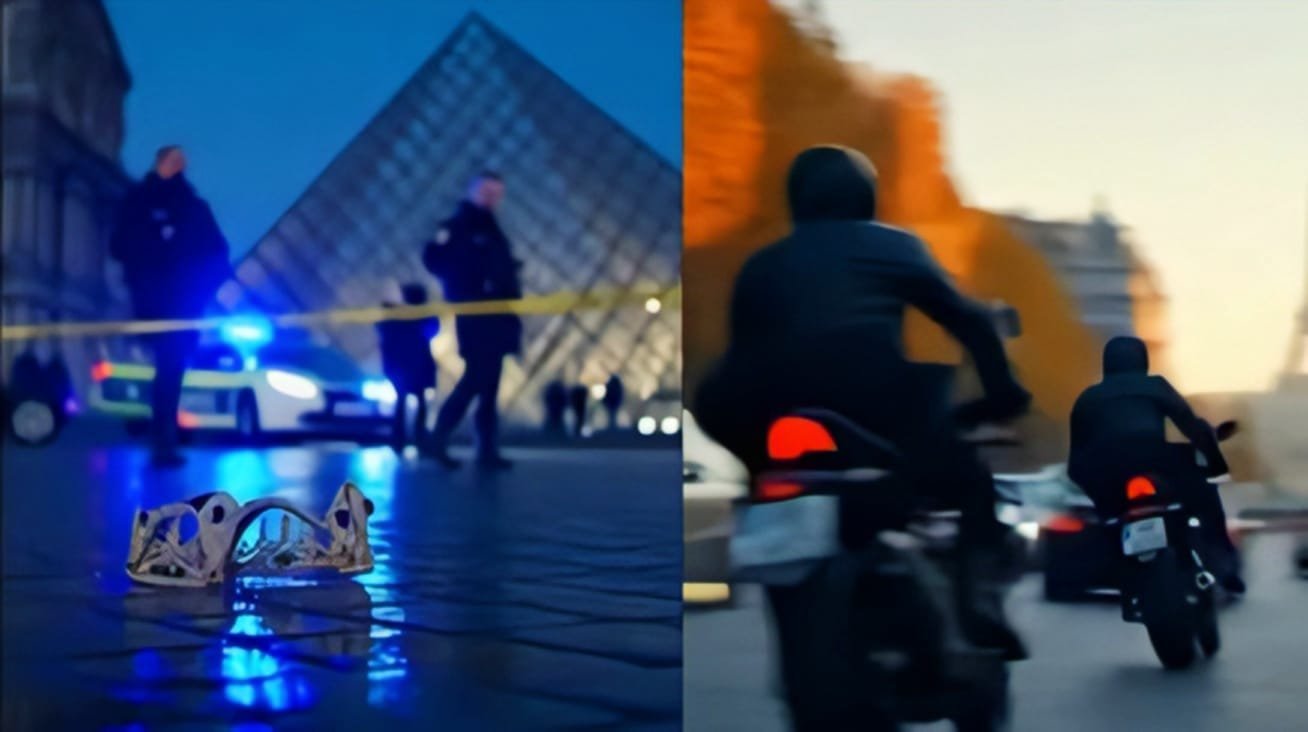
The Louvre became the virtual stage for one of the most realistic AI-generated heist videos ever seen.
Introduction: When reality became cinema AI Louvre Heist
On a quiet Paris morning, hundreds of tourists were capturing Mona Lisa’s smile with their cameras within the towering walls of the Louvre Museum. At the same time, just a few kilometers away, one of history’s most daring and mysterious heists was taking place. Precious jewels from the French Crown, valued at approximately US$100 million (approximately ₹835 crore), were stolen from the Louvre, bypassing its security.
The AI Video — Turning Reality into Cinema But it was later revealed that this was an AI-generated video, meaning someone had created film scenes using artificial intelligence, not actual footage. Why did it go viral? The video was so realistic and stylish that people believed it was actual footage of the theft. Hashtags began trending on Twitter (now X), Instagram, and YouTube: > #LouvreHeist #Dhoom2InParis #AIRealism One user wrote > “If Hrithik Roshan were in the real world, he would have done the same!” Another joked > “The Louvre security should have learned from the Dhoom series.”
The Cinema of Social Media — Crime or Art?
This video demonstrated that today, social media can turn any incident into a movie in a matter of hours. People created Reel versions of the video, added Dhoom background music, and even started “heist challenges.” This was a strange twist where real crime became entertainment. Many experts warned that such AI videos affect people’s sense of reality. When crime is portrayed as “cool” or “stylish,” its moral gravity diminishes in society.
Has AI made crime easier? on AI Louvre Heist
This incident raises a significant question: Is AI, which can now create videos, alter voices, and create false images, becoming a new motivation for criminals? According to legal experts, “AI glamorizes the image of crime. When people see it like movies, the condemnation of crime decreases.” AI-generated videos are now the latest addition to deepfake technology. They also complicate police investigations, as it’s difficult to distinguish between real and fake footage.
Public Reaction — “Dhoom 2 in Real Life!” The internet witnessed a mix of humor, satire, and excitement regarding the theft. Some said, “This wasn’t a real crime, it was an artistic performance.” Others said, “If Aryan (the character from Dhoom 2) were real, this is what he would do—steal the crown from the Louvre.” Memes and Reels began featuring Hrithik Roshan and images of the Louvre. A TikTok “#DhoomHeistChallenge” began, with people creating fake heist videos.
Expert Opinion — Entertainment vs. Morality
Prof. Julien Moreau (Art Historian, Sorbonne University) “When heritage theft is portrayed as entertainment, we devalue our culture.” Cyber-expert Amélie Dubois said, “AI has changed the narrative. The fake video went more viral than the actual crime. This is a test of our digital ethics.” Police Chief Lucas Martin > “The theft was professional, but the AI video confused the investigation. Many people mistook it for real footage.”
AI Art vs. Crime — A Philosophical Perspective The way AI recreated this incident raises a profound question: Can artificial intelligence beautify the truth and turn it into a lie? It’s fun to say “Dhoom 2-style,” but when historical objects are stolen, it’s not just style, it’s history that’s lost. Human consciousness now lives on two levels: one, digital imagination, where everything seems cinematic; the other, physical reality, where crime and suffering are real.
Future Direction — Security and Sensitivity Museum security is now implementing biometric sensors, motion alarms, and AI-surveillance technology in museums. The European Union is considering applying a “Reality Label” to AI content to determine whether the video is real or generated. Public media literacy must teach people that not every viral video is true. Protecting Culture Art theft should be seen not just as a “heist movie,” but as “culture murder.”
Conclusion—When reality surpassed fiction and AI Louvre Heist
This Louvre theft demonstrates that the boundaries between crime and entertainment have blurred in the 21st century. On one hand, there was the audacity and technical preparedness of the thieves, and on the other, the imagination of the public and the magic of AI. When people say today, “It was a Dhoom 2-like heist,” they are essentially saying that movies have become reality, and reality has become reality. Reality films are being made. This incident also taught us that technology, no matter how dazzling, can blur history, art, and truth when used in the wrong hands. Final Thoughts AI-video has exposed not just a theft, but also the curiosity and confusion of the human mind. People now find “entertainment” in everything. It’s time to think whether we are starting to prefer beautiful lies to the truth?




